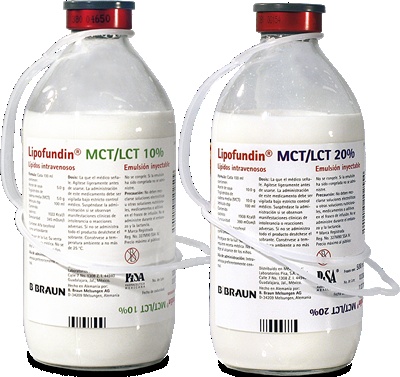

LIPOFUNDINA MCT/LCT 10% EMULSION FOR INFUSION

Ask a doctor about a prescription for LIPOFUNDINA MCT/LCT 10% EMULSION FOR INFUSION

How to use LIPOFUNDINA MCT/LCT 10% EMULSION FOR INFUSION
Introduction
Package Leaflet: Information for the User
Lipofundin MCT/LCT 10% Emulsion for Infusion
Soybean oil, refined; medium-chain triglycerides
Read all of this leaflet carefully before you start using this medicine because it contains important information for you.
- Keep this leaflet, you may need to read it again.
- If you have any further questions, ask your doctor, pharmacist, or nurse.
- This medicine has been prescribed for you only. Do not pass it on to others. It may harm them, even if their signs of illness are the same as yours.
- If you get any side effects, talk to your doctor, pharmacist, or nurse. This includes any possible side effects not listed in this leaflet. See section 4.
Contents of the pack
- What Lipofundin MCT/LCT 10% is and what it is used for
- What you need to know before you use Lipofundin MCT/LCT 10%
- How to use Lipofundin MCT/LCT 10%
- Possible side effects
- Storage of Lipofundin MCT/LCT 10%
- Contents of the pack and other information
1. What Lipofundin MCT/LCT 10% is and what it is used for
Lipofundin MCT/LCT 10% is an oil-in-water emulsion. The oils in Lipofundin MCT/LCT 10% provide energy and contain essential fatty acids, which are necessary for the functions of your body, that your body needs to grow and recover.
Lipofundin MCT/LCT 10% is given to you through a drip in a vein (infusion) as part of a treatment for nutrition because you are unable to eat properly or cannot be fed through a nasogastric tube.
2. What you need to know before you use Lipofundin MCT/LCT 10%
Do not use Lipofundin MCT/LCT 10%
- If you are allergic to egg or soy protein or to any of the other ingredients of this medicine (listed in section 6).
Do not use Lipofundin MCT/LCT if you have any of the following:
- severe increase in blood fat levels (severe hyperlipidemia)
- a disorder in which the blood does not clot properly (severe coagulopathy, bleeding diathesis)
- severe liver failure
- disruption of bile flow (intrahepatic cholestasis)
- blockage of blood vessels by blood clots or fat (acute thromboembolic events, lipid embolism)
- disorders in which the blood is too acidic (metabolic acidosis)
- potentially life-threatening circulation problems, such as those that occur if you are in a state of collapse or shock
- acute phase of heart attack (myocardial infarction) or stroke
- severe kidney failure without dialysis treatment
- untreated disturbances of water and salt balance (electrolyte imbalance), for example, low water and salt content in the body (hypotonic dehydration) or low potassium levels (hypokalemia) in your blood
- severe heart failure (decompensated heart failure)
- fluid accumulation in the lungs (acute pulmonary edema)
Warnings and precautions
Tell your doctor, pharmacist, or nurse before you start using Lipofundin MCT/LCT.
During infusion, your doctor should regularly monitor the amount of fat in your blood (serum triglycerides). If your blood fat levels become too high, your doctor may reduce the infusion rate or stop it.
Before you receive this medicine, your doctor should correct any existing disturbances of the water and salt content of your body, as well as any disturbances of your acid-base balance.
While you are receiving this solution, your doctor should check your fluid, electrolyte, and acid-base balance, as well as your heart function. Your doctor may consider it necessary for you to receive this solution for several weeks. In this case, your liver function and blood coagulation will be closely monitored, and blood counts will be performed.
Allergic reactions to this medicine are extremely rare. If you show signs of an allergic reaction when you receive this medicine, such as fever, chills, hives, or breathing problems, your doctor should stop the infusion immediately.
In addition to Lipofundin MCT/LCT, you may receive a carbohydrate solution and an amino acid solution to prevent metabolic conditions in which your blood becomes acidic (metabolic acidosis).
To make your intravenous nutrition complete, you may also receive carbohydrate and amino acid solutions. The nursing staff may also take measures to ensure that your body's needs for fluids, electrolytes, vitamins, and trace elements are met.
When used in children from premature birth to 2 years, the emulsion (including administration equipment) should be protected from light exposure after preparation for infusion until administration is completed (see section 2).
Use of Lipofundin MCT/LCT 10% with other medicines
Tell your doctor or pharmacist if you are taking, have recently taken, or might take any other medicines.
Lipofundin MCT/LCT may interact with some medicines. Tell your doctor if you are taking or receiving certain medicines to control blood clotting, i.e.,
- heparin
- cumarin derivatives, e.g., Warfarin
Pregnancy, breastfeeding, and fertility
If you are pregnant or breastfeeding, think you may be pregnant, or are planning to have a baby, ask your doctor for advice before taking this medicine.
There is limited experience with the use of Lipofundin MCT/LCT in pregnant women. If you are pregnant, you will receive this medicine only if your doctor considers it absolutely necessary for your recovery.
Breastfeeding is not recommended in women under parenteral nutrition.
Driving and using machines
Lipofundin MCT/LCT is usually given to patients in a controlled environment (a hospital or clinic). This will exclude driving and use of machines.
Important information about some of the ingredients of Lipofundin MCT/LCT 10%
This medicine contains less than 1 mmol of sodium (23 mg) per liter; it is essentially "sodium-free".
3. How to use Lipofundin MCT/LCT 10%
This medicine is given through a drip in a vein (infusion), i.e., through a small tube directly into a vein.
The following doses are guidelines. Your doctor will decide what amount of this medicine you need and for how long you need treatment with this medicine.
Adults
A daily dose of 0.7-1.3 g of lipids per kg of body weight and day is recommended. In case of increased energy requirements, your doctor may administer up to 1.5 g per kg of body weight and day. Your energy requirements may be increased in case of cancer or certain diseases.
In the following patient groups, the administration of intravenous lipids should not exceed 1 g per kg of body weight and day:
- Patient receiving long-term home treatment (>6 months)
- Patients with short bowel syndrome
For a patient with a body weight of 70 kg, a daily dose of 1.5 g per kg of body weight and day corresponds to a maximum daily dose of 1,050 ml of Lipofundin MCT/LCT 10%.
Pediatric population
A successive increase in lipids by 0.5-1 g per kg of body weight and day may be beneficial. It can help the doctor monitor the increase in plasma triglyceride levels and prevent excessively high lipid levels (hyperlipidemia).
Preterm, newborn, and infant
A daily dose of lipids should not exceed 3 (max. 4 g) per kg of body weight and day.
In this age group, the daily dose of lipids should be infused continuously over approximately 24 hours.
Children and adolescents
A daily dose of lipids should not exceed 2-3 g per kg of body weight and day.
Infusion rate
The infusion should be administered at the lowest possible rate. During the first 15 minutes, the infusion rate should be 50% of the maximum infusion rate used. The doctor should closely monitor the patient for the appearance of side effects.
Maximum infusion rate
Adults
Up to 0.10 g of lipids per kg of body weight and hour.
For a patient with a body weight of 70 kg, this corresponds to a maximum infusion rate of 70 ml per hour of Lipofundin MCT/LCT 10%. The amount of lipids administered is then 7 g per hour.
Preterm, newborn, and infant
Up to 0.17 g of lipids per kg of body weight and hour.
Children and adolescents
Up to 0.13 g of lipids per kg of body weight and hour.
When used in children from premature birth to 2 years, the emulsion (including administration equipment) should be protected from light exposure after preparation for infusion until administration is completed (see section 2).
If you use more Lipofundin MCT/LCT 10% than you should
If you have received too much Lipofundin MCT/LCT, your fat levels may become abnormally high (hyperlipidemia), your blood may become too acidic (metabolic acidosis), or you may experience a condition called "fat overload syndrome". For symptoms of fat overload syndrome, see section 4.
If these side effects occur during treatment, the infusion of Lipofundin MCT/LCT should be stopped. The infusion will not be restarted until you have recovered. Your doctor may need to adjust your daily fat doses. Your doctor will decide on any additional treatment.
4. Possible side effects
Like all medicines, Lipofundin MCT/LCT can cause side effects, although not everybody gets them.
The following side effects can be serious. If you experience any of the following side effects, tell your doctor immediately and stop using this medicine:
Very rare (may affect up to 1 in 10,000 people)
? allergic reactions, e.g., skin reactions, difficulty breathing, swelling of the lips, mouth, and throat, difficulty swallowing
? breathing problems (dyspnea)
? blue discoloration of the skin (cyanosis)
Other side effects:
Very rare (may affect up to 1 in 10,000 people)
? fat overload syndrome (see "fat overload syndrome" below)
? increased tendency of your blood to clot (hypercoagulability)
? abnormally high levels of fat in the blood (hyperlipidemia)
? abnormally high levels of sugar in the blood (hyperglycemia)
? metabolic conditions in which your blood becomes acidic (metabolic acidosis, ketoacidosis)
? decrease or increase in blood pressure
? drowsiness
? nausea, vomiting, loss of appetite
? headache
? flushing
? redness of the skin (erythema)
? high body temperature
? sweating
? feeling of cold, chills
? back, bone, chest, and lumbar pain
Not known (frequency cannot be estimated from the available data)
? disruption of bile flow (cholestasis)
? decrease in white blood cell count (leukopenia)
? decrease in platelet count (thrombocytopenia)
Fat overload syndrome
You may have "fat overload syndrome" if you have received too much Lipofundin MCT/LCT or when your body has problems with fats. Your body's ability to use fats may be influenced by a sudden change in your condition (due to kidney problems or infection). The symptoms are usually reversible if the infusion is stopped. Fat overload syndrome is characterized by the following symptoms:
? high levels of fat in the blood (hyperlipidemia)
? fever
? fat deposits in the liver or other organs (fatty infiltration)
? enlargement of the liver (hepatomegaly), which may be accompanied by jaundice
? enlargement of the spleen (splenomegaly)
? decrease in red blood cell count (anemia)
? decrease in white blood cell count (leukopenia)
? decrease in platelet count (thrombocytopenia)
? blood coagulation disorder
? breakdown of blood cells (hemolysis)
? increase in immature red blood cells (reticulocytosis)
? abnormal liver function tests
? loss of consciousness
Reporting of side effects
If you experience any side effects, talk to your doctor, pharmacist, or nurse. This includes any possible side effects not listed in this leaflet. You can also report side effects directly via the Spanish Medicines Monitoring System www.notificaRAM.es
5. Storage of Lipofundin MCT/LCT 10%
Keep this medicine out of the sight and reach of children.
Do not use this medicine after the expiry date which is stated on the label. The expiry date refers to the last day of the month stated.
Do not store above 25°C. Do not freeze. The product should be discarded if it has been frozen.
Store the vials in the outer packaging to protect them from light.
When used in children from premature birth to 2 years, the emulsion (including administration equipment) should be protected from light exposure after preparation for infusion until administration is completed (see section 2).
6. Container Content and Additional Information
Composition of Lipofundina MCT/LCT 10%
The active ingredients per 1,000 ml of Lipofundina MCT/LCT 10% are:
Refined soybean oil 50.0 g
Medium-chain triglycerides (MCT) 50.0 g
Content of essential fatty acids in 1,000 ml:
Linoleic acid 24.0-29.0 g/l
α-Linolenic acid 2.5-5.5 g/l
Total energy [kJ/l (kcal/l)] | 4,330 (1,035) |
Theoretical osmolality [mOsm/l] | 345 |
Acidity or alkalinity (titration up to pH 7.4) [mmol/l] | < 0.5 |
pH | 6.0-8.8 |
The other components are glycerol, egg phospholipids for injectable preparations, all-rac-α-tocopherol, sodium oleate (for pH adjustment), and water for injectable preparations.
Appearance of the Product and Container Content
Lipofundina MCT/LCT is a white, milky emulsion. It is an emulsion for infusion, i.e., it is administered through a small tube in a vein.
It is available in sealed glass bottles with rubber stoppers containing:
? 100 ml, available in packs of 1 x 100 ml
? 250 ml, available in packs of 1 x 250 ml
? 500 ml, available in packs of 1 x 500 ml
Marketing Authorization Holder and Manufacturer
Marketing authorization holder:
- Braun Medical, S.A.
Ctra. de Terrassa, 121
08191-Rubí (Barcelona)
Spain
Manufacturer:
- Braun Melsungen AG
Carl-Braun-Strasse 1
D-34212 Melsungen, Germany
Phone: +49-5661-71-3383
Fax: +49-5661-75-3383
Date of the Last Revision of this Leaflet: October 2022
This information is intended only for healthcare professionals:
Additional Special Warnings and Precautions for Use
Mixing with incompatible substances can lead to separation of the emulsion or precipitation of particles, which carries a high risk of embolism.
In solutions with a higher lipid concentration (e.g., Lipofundina MCT/LCT 20%), the ratio of emulsifier (phospholipid) to oil is lower than in less concentrated lipid emulsions. This ensures a lower and more favorable plasma concentration of triglycerides, phospholipids, free fatty acids, and pathological lipoprotein-X in the patient's blood. Therefore, emulsions with higher lipid concentrations, such as Lipofundina MCT/LCT 20%, should be preferred over less concentrated lipid emulsions.
Exposure to light of parenteral nutrition mixtures for intravenous administration, especially after mixing with trace elements or vitamins, can have adverse effects on the clinical outcome of newborns due to the generation of peroxides and other degradation products. When used in children from premature birth to 2 years, Lipofundina MCT/LCT 10% should be protected from light after preparation for infusion until the end of administration.
Interference with Laboratory Tests
Lipids can interfere with certain laboratory tests (such as bilirubin, lactate dehydrogenase, oxygen saturation) when the blood sample is taken before the lipids have been eliminated from the bloodstream. This can take between 4 and 6 hours.
Incompatibilities
Lipofundina MCT/LCT should not be used as a carrier solution for electrolyte concentrates or other pharmaceutical products, nor should the emulsion be mixed with other infusion solutions in an uncontrolled manner, as the stability of the emulsion would no longer be guaranteed.
Special Precautions for Disposal and Other Handling
Shake lightly before use.
The emulsion should be brought to room temperature without assistance before infusion, i.e., the product should not be placed in a heating device (such as an oven or microwave).
If filters are used, they must be lipid-permeable.
Before infusing a lipid emulsion together with other solutions through a Y-connector or bypass set, the compatibility of these liquids should be checked, especially when administered with vehicle solutions to which drugs have been added. Particular care should be taken when infusing solutions that contain divalent electrolytes (such as calcium or magnesium) simultaneously.
When using the product packaged in flexible bags, the air outlet of the administration equipment must be closed.
When used in children from premature birth to 2 years, parenteral nutrition mixtures containing Lipofundina MCT/LCT 10% should be protected from light exposure after preparation for infusion until the end of administration. Exposure of such mixtures to light, especially after mixing with trace elements or vitamins, generates peroxides and other degradation products that can be reduced by protecting the product from light exposure.
Method of Administration
Lipid emulsions are suitable for peripheral venous administration and can also be administered separately through peripheral veins as part of complete parenteral nutrition.
If lipid emulsions are administered simultaneously with amino acid and carbohydrate solutions, the Y-connector or bypass should be placed as close to the patient as possible.
Normally, the duration of administration of Lipofundina MCT/LCT 10% is between 1 and 2 weeks. If continued parenteral nutrition with lipid emulsions is indicated, Lipofundina MCT/LCT 10% can be administered for longer periods, provided that adequate monitoring is implemented.
Normally, the duration of administration of Lipofundina MCT/LCT 10% is between 1 and 2 weeks. If continued parenteral nutrition with lipid emulsions is indicated, Lipofundina MCT/LCT 10% can be administered for longer periods, provided that adequate monitoring is implemented.
When used in children from premature birth to 2 years, the emulsion (including administration equipment) should be protected from light exposure after preparation for infusion until the end of administration.
- Country of registration
- Active substance
- Prescription requiredYes
- Manufacturer
- This information is for reference only and does not constitute medical advice. Always consult a licensed doctor before taking any medication. Oladoctor is not responsible for medical decisions based on this content.
- Alternatives to LIPOFUNDINA MCT/LCT 10% EMULSION FOR INFUSIONDosage form: INJECTABLE PERFUSION, 200 mg/mlActive substance: fat emulsionsManufacturer: Baxter S.L.Prescription requiredDosage form: INJECTABLE PERFUSION, 20 gActive substance: fat emulsionsManufacturer: Fresenius Kabi España, S.A.U.Prescription requiredActive substance: fat emulsionsManufacturer: B Braun Medical S.A.Prescription required
Alternatives to LIPOFUNDINA MCT/LCT 10% EMULSION FOR INFUSION in other countries
The best alternatives with the same active ingredient and therapeutic effect.
Alternative to LIPOFUNDINA MCT/LCT 10% EMULSION FOR INFUSION in Польша
Alternative to LIPOFUNDINA MCT/LCT 10% EMULSION FOR INFUSION in Украина
Online doctors for LIPOFUNDINA MCT/LCT 10% EMULSION FOR INFUSION
Discuss dosage, side effects, interactions, contraindications, and prescription renewal for LIPOFUNDINA MCT/LCT 10% EMULSION FOR INFUSION – subject to medical assessment and local rules.














